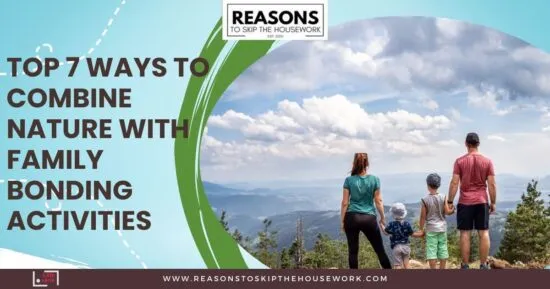Ever feel like your family spends more time scrolling than talking? You’re not alone.
But what if the antidote isn’t a lecture on screen time: it’s a backpack, a mountain trail, and a shared laugh echoing through the trees? Nature doesn’t just calm the mind, it resets the rhythm of how families engage with one another.
Ready to swap screen fatigue for fresh air and genuine fun? Read on to learn more.

Contents
- 1. Take Your Meals Outside: Italian-Style Picnicking
- 2. Go On a Vacation
- 3. Turn Outdoor Time into Games and Traditions
- 4. Document the Journey Creatively
- 5. Work Together on a Family Nature Project
- 6. Let the Landscape Spark Big Conversations
- 7. Choose the Right Destinations with Shared Value
- Bond In Nature Today
1. Take Your Meals Outside: Italian-Style Picnicking
One of the easiest ways to bring nature into your family’s routine is to turn mealtime into a mini adventure. Rather than sticking to the kitchen table, pack a basket with:
- Crusty bread
- Olive
- Cheeses
- Seasonal fruit
- Sparkling water
And head to a nearby park or forest clearing.
Add a few lightweight blankets and reusable dishes to keep the experience eco-friendly and cozy. Younger kids can help scout the best picnic spot, while older ones might enjoy learning to set up a European-style al fresco layout.
2. Go On a Vacation
Don’t be afraid to take a trip. Trekking from one mountain hut to another gives each day a purpose and turns the journey itself into the destination.
The experience of unplugging, navigating trails together, and reaching cozy lodgings by nightfall creates a rhythm that encourages connection in a way everyday routines rarely do.
Some of the most scenic and well-organized routes can be found across Europe, where established networks of alpine huts make the experience both accessible and unforgettable. Dolomites hut to hut hiking is a great place to start exploring the possibilities.
Whether you end up crossing high ridges or winding through gentle valleys, the lasting takeaway is the bond formed when families face the trail together.
3. Turn Outdoor Time into Games and Traditions
Children of all ages respond well to play, and there’s no shortage of games that translate beautifully into natural spaces. Classic options like:
- Capture the flag
- Flashlight tag
- Scavenger hunts
Are easy to tailor for any terrain. Add in a family-made obstacle course using tree stumps, logs, or rocks, and you’ve got a full afternoon of friendly competition.
Beyond games, think about rituals. Maybe every hike ends with a trail-side storytelling session, or each camping trip begins with everyone contributing a “wild card” snack to share. These small but repeated acts create structure and anticipation, building a rhythm that families will look forward to every time they go outside together.
4. Document the Journey Creatively
Nature-based bonding doesn’t have to stop when the activity ends. Encourage each family member to record the experience in a way that speaks to them.
Kids might create nature journals with pressed flowers, trail sketches, or daily notes about what they saw. Teens might prefer to shoot short video clips or take artistic photos. Parents might log miles hiked or collect local recipes to recreate at home.
Once the trip is over, come together and make a scrapbook, slideshow, or even just a dedicated photo folder to revisit during slower months. It’s a powerful way to keep those outdoor moments alive and spark conversations long after the backpacks are unpacked.
5. Work Together on a Family Nature Project
Nothing builds unity quite like working toward a shared goal, and nature-based projects are the perfect outlet for this kind of collaboration. Set up a backyard wildlife habitat using native plants. Build a simple tree swing or birdhouse. Volunteer together on a local trail maintenance day. Choose a conservation cause and raise funds or awareness as a team.
These kinds of efforts foster a sense of purpose and ownership. Plus, they create a physical legacy – a patch of pollinator-friendly flowers, a bench by a trail, a cleaned-up shoreline – that serves as a reminder of what can happen when everyone pitches in.
6. Let the Landscape Spark Big Conversations
One of the underestimated benefits of getting outdoors as a family is the way it opens the door to deeper discussions. The quiet of a hike, the rhythm of paddling, or the simplicity of stargazing makes space for questions that might not surface around the dinner table.
Talk about resilience while climbing switchbacks. Reflect on growth while watching saplings in a forest. Open up about dreams and goals while soaking in a sunset. These natural metaphors help young people connect to larger ideas in ways that feel grounded and safe. It’s not just about where you go but the conversations that happen while you’re out there.
Not every nature spot offers the same vibe. Some families may prefer quiet lakes for paddling and fishing, while others might lean toward more dramatic options like the Monkey Forest. Let everyone in the family help choose your next outdoor destination, ensuring buy-in and anticipation from the start.
National parks closer to home and even local preserves can provide the canvas. What matters is how you experience it together. If your family enjoys food, plan stops with regional tastings. If you’re a crew of storytellers, find places tied to legends or folklore. Make the location an extension of your collective interests, and the bond will build itself.
Bond In Nature Today
Families that spend time in nature together often come away with more than beautiful photos or a few tired legs. They leave with stronger bonds and a shared sense of wonder that no screen can replicate.
